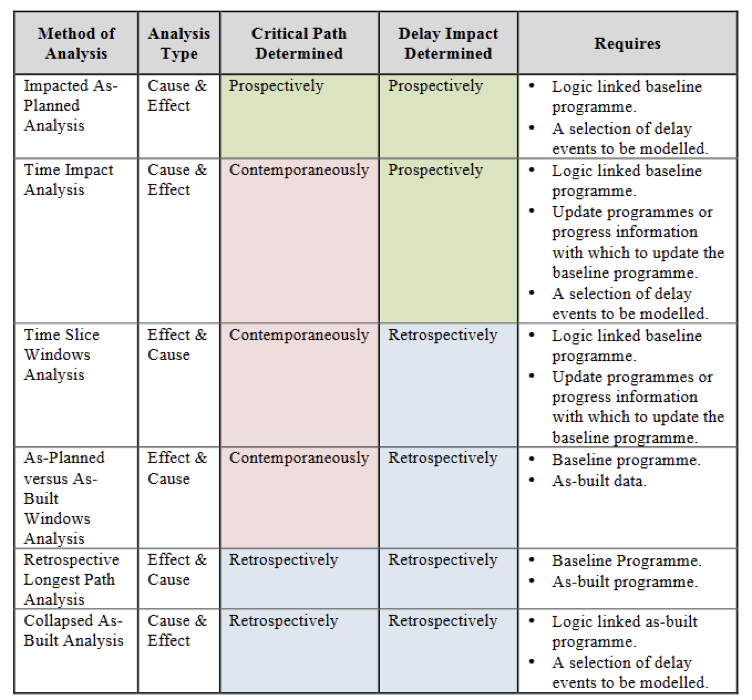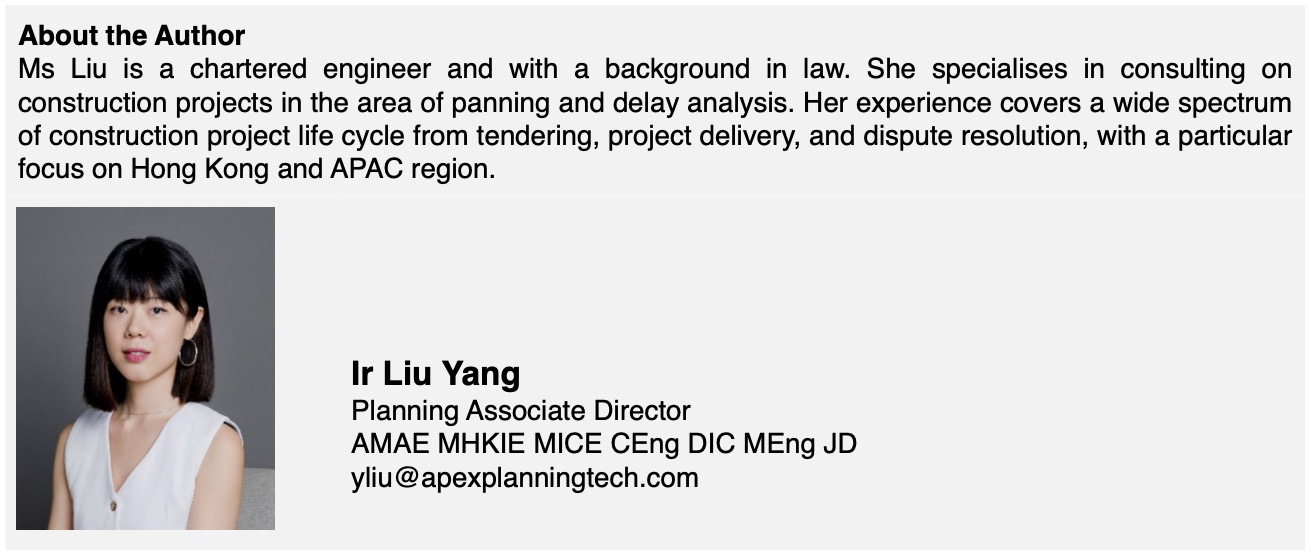by Ir Liu Yang Planning Associate Director, AMAE MHKIE MICE CEng DIC MEng JD
When encountering a delay event, such as adverse weather conditions, design changes, unforeseeable ground conditions, or acts by third parties, it can have an impact on the project completion date. In such cases, the affected party may be entitled to an Extension of Time (EoT) as per the contract terms. An EoT entitlement refers to the right to a party to extend the project's completion date. Unless the contract explicitly states that the completion date is non-extendable, the party should be given a reasonable time of extension to complete the work. To establish a sound and robust EoT claim, a delay analysis should be conducted in accordance with the contract's stipulated requirements.
There are methods for assessing two different types of delays: prospective (forecast) delay and retrospective (actual) delay. It is commonly understood that prospective (forecast) delay analysis tends to favour the Contractor, while retrospective (actual) delay analysis favours the Employer However, the suitable method of assessment should be determined based on the specific contract terms, and failure to meet the contract's requirements may result in the Contractor's EoT assessment being completely ruled out.
To explain the suggested method of delay analysis indicated in internationally used standard contracts, I have extracted the relevant contract clauses from NEC, FIDIC and SIA for illustration.
NEC Contract
The NEC (New Engineering Contract) is a suite of contracts that are widely used in the construction industry for various types of projects. NEC contracts are known for their emphasis on collaboration, clear communication, and effective risk management.
NEC4 Clause 63.5
“A delay to the Completion Date is assessed as the length of time that, due to the compensation event, planned Completion is later than planned Completion as shown the Accepted Programme current the dividing date.
…
When assessing delay only those operations which the Contractor has not completed and which are affected by the compensation event are changed.”
NEC Clause 62.2
“Quotations for a compensation event comprise proposed changes to the Prices and any delay to the Completion Date and Key Dates assessed by the Contractor. The Contractor submits details of the assessment with each quotation. If the programme for remaining is altered by compensation event, the Contractor includes the alterations to the Accepted Programme in the quotation."
In the NEC contract, if a compensation event occurs that will result in the planned completion date being delayed, the Contractor has the right to submit a quotation to claim for additional time and cost.
Clause 63.5 of the NEC contract states that the assessment of delay should be based on the Accepted Programme up to the dividing date. The dividing date is not specifically defined and can be agreed upon between the Contractor and the Employer. It can be the date of the Early Warning, Notification of Compensation Event, or any other relevant date related to the delay event. Introducing the concept of a dividing date implies the use of a revised programme that incorporates the actual progress of the project up to the cutoff date of the programme update. Assessing the delay using the revised programme means considering the contemporaneous critical path for the delay analysis.
Furthermore, Clause 62.2 states that any delay should be included in the quotation for the compensation event, which means that all delays identified by the Contractor can be included in the assessment. The term "any delay" suggests the application of the prospective (forecast) delay analysis method.
The NEC contract also introduces a mechanism for correcting any assumptions made by the Employer regarding the assessment of delay. If the Employer decides to correct a previous assumption, the delay analysis needs to be reassessed once a compensation event is raised to correct the assumption.
FIDIC Contract
The FIDIC (International Federation of Consulting Engineers) contract is a widely recognised and commonly used standard form of contract in the international construction industry. FIDIC contracts are known for their comprehensive coverage of contractual provisions and guidance on various aspects of construction projects.
FIDIC Clause 20.1 Contractors Claims
“If the Contractor considers himself to be entitled to any extension of the Time for Completion and/or any additional payment, under any Clause of the Conditions or otherwise in connection with the Contract…
…
Within 42 days after the Contractor became aware (or should have become aware) of the event or circumstance giving rise to the claim, or within such other period as may be proposed by the Contractor and approved by the Employer, the Contractor shall send to the Employer a fully detailed claim which includes full supporting particulars of the basis of the claim and of the extension of time and/or additional payment claimed. If the event or circumstance giving rise to the claim has a continuing effect:
- (a)this full detailed claim shall be considered as interim;
- (b)The Contractor shall send further interim claims at monthly intervals, giving the accumulated delay and/or amount claimed, and such further particulars as the Employer may reasonably require; and
- (c)The Contractor shall send a final claim within 28 days after the end of the effects resulting from the event or circumstance, or within such other period as may be proposed by the Contractor and approved by the Employer.”
In the FIDIC contract, clear condition precedents are established for the Contractor to submit a claim seeking an extension of time. One such condition is the requirement to submit a final claim within 28 days after "the end of the effects resulting from the event or circumstance." This suggests that the Contractor should analyse the retrospective (actual) delay after the delay event has concluded and its effects have ceased.
SIA Conditions of Contract
SIA Conditions of Contract (Singapore Institute of Architects' Conditions of Contract) is a contact used in private sector projects. It provides a framework for defining the rights, obligations, and responsibilities of the parties involved in construction projects in Singapore.
SIA Clause 23(3)
“After any delaying factor in respect of which an extension of time is permitted by the Contract has ceased to operate and it is possible to decide the length of the period of extension beyond the Contract Completion Date (or any previous extension thereof) in respect of such matter, the Architect shall determine such period of extension and shall at any time up to and including the issue of the Final Certificate notify the Contractor in writing of his decision and estimate of the same”
Similar to the FIDIC contract, the SIA contract also requires the assessment of EoT after the delay factor "has ceased to operate”. This indicates the need to study the retrospective (actual) delay, considering the impact of the delay factor once it is no longer affecting the project.
Delay analysis involves identifying and assessing period and cause of delay to determine their impact to the project completion date. The Society of Construction Law “Delay and Disruption Protocol” provides valuable guidance in this area, presenting six methods of analysis. The table of delay analysis method is extracted as below. The protocol is available at https://www.scl.org.uk/sites/default/files/documents/SCL_Delay_Protocol_2nd_Edition_Final.pdf.



